Specialist Areas Being Adopted by Nurses
VerifiedAdded on 2022/08/22
|9
|2788
|29
AI Summary
Contribute Materials
Your contribution can guide someone’s learning journey. Share your
documents today.

Nursing
Student’s name:
Institutional:
Student’s name:
Institutional:
Secure Best Marks with AI Grader
Need help grading? Try our AI Grader for instant feedback on your assignments.
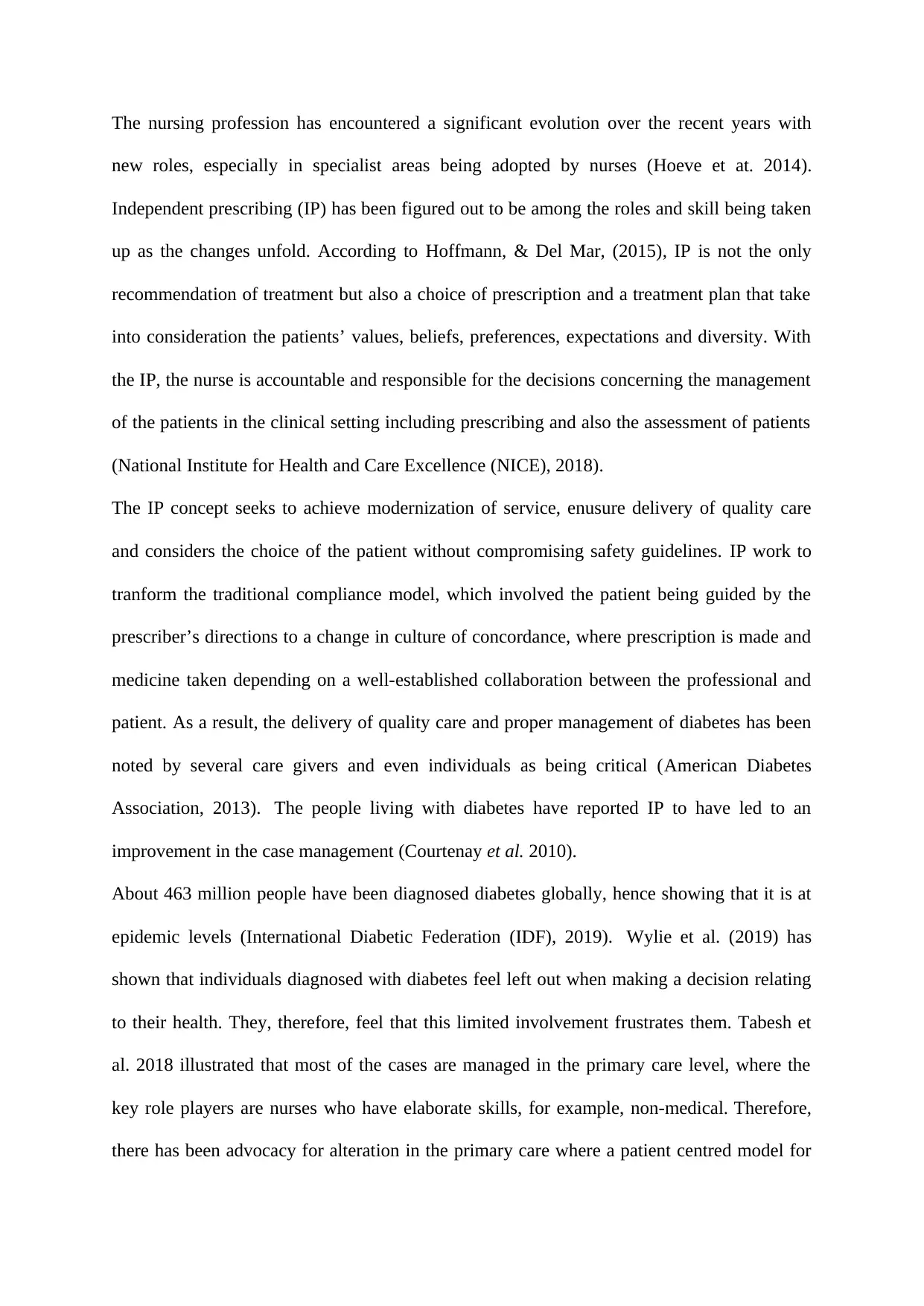
The nursing profession has encountered a significant evolution over the recent years with
new roles, especially in specialist areas being adopted by nurses (Hoeve et at. 2014).
Independent prescribing (IP) has been figured out to be among the roles and skill being taken
up as the changes unfold. According to Hoffmann, & Del Mar, (2015), IP is not the only
recommendation of treatment but also a choice of prescription and a treatment plan that take
into consideration the patients’ values, beliefs, preferences, expectations and diversity. With
the IP, the nurse is accountable and responsible for the decisions concerning the management
of the patients in the clinical setting including prescribing and also the assessment of patients
(National Institute for Health and Care Excellence (NICE), 2018).
The IP concept seeks to achieve modernization of service, enusure delivery of quality care
and considers the choice of the patient without compromising safety guidelines. IP work to
tranform the traditional compliance model, which involved the patient being guided by the
prescriber’s directions to a change in culture of concordance, where prescription is made and
medicine taken depending on a well-established collaboration between the professional and
patient. As a result, the delivery of quality care and proper management of diabetes has been
noted by several care givers and even individuals as being critical (American Diabetes
Association, 2013). The people living with diabetes have reported IP to have led to an
improvement in the case management (Courtenay et al. 2010).
About 463 million people have been diagnosed diabetes globally, hence showing that it is at
epidemic levels (International Diabetic Federation (IDF), 2019). Wylie et al. (2019) has
shown that individuals diagnosed with diabetes feel left out when making a decision relating
to their health. They, therefore, feel that this limited involvement frustrates them. Tabesh et
al. 2018 illustrated that most of the cases are managed in the primary care level, where the
key role players are nurses who have elaborate skills, for example, non-medical. Therefore,
there has been advocacy for alteration in the primary care where a patient centred model for
new roles, especially in specialist areas being adopted by nurses (Hoeve et at. 2014).
Independent prescribing (IP) has been figured out to be among the roles and skill being taken
up as the changes unfold. According to Hoffmann, & Del Mar, (2015), IP is not the only
recommendation of treatment but also a choice of prescription and a treatment plan that take
into consideration the patients’ values, beliefs, preferences, expectations and diversity. With
the IP, the nurse is accountable and responsible for the decisions concerning the management
of the patients in the clinical setting including prescribing and also the assessment of patients
(National Institute for Health and Care Excellence (NICE), 2018).
The IP concept seeks to achieve modernization of service, enusure delivery of quality care
and considers the choice of the patient without compromising safety guidelines. IP work to
tranform the traditional compliance model, which involved the patient being guided by the
prescriber’s directions to a change in culture of concordance, where prescription is made and
medicine taken depending on a well-established collaboration between the professional and
patient. As a result, the delivery of quality care and proper management of diabetes has been
noted by several care givers and even individuals as being critical (American Diabetes
Association, 2013). The people living with diabetes have reported IP to have led to an
improvement in the case management (Courtenay et al. 2010).
About 463 million people have been diagnosed diabetes globally, hence showing that it is at
epidemic levels (International Diabetic Federation (IDF), 2019). Wylie et al. (2019) has
shown that individuals diagnosed with diabetes feel left out when making a decision relating
to their health. They, therefore, feel that this limited involvement frustrates them. Tabesh et
al. 2018 illustrated that most of the cases are managed in the primary care level, where the
key role players are nurses who have elaborate skills, for example, non-medical. Therefore,
there has been advocacy for alteration in the primary care where a patient centred model for
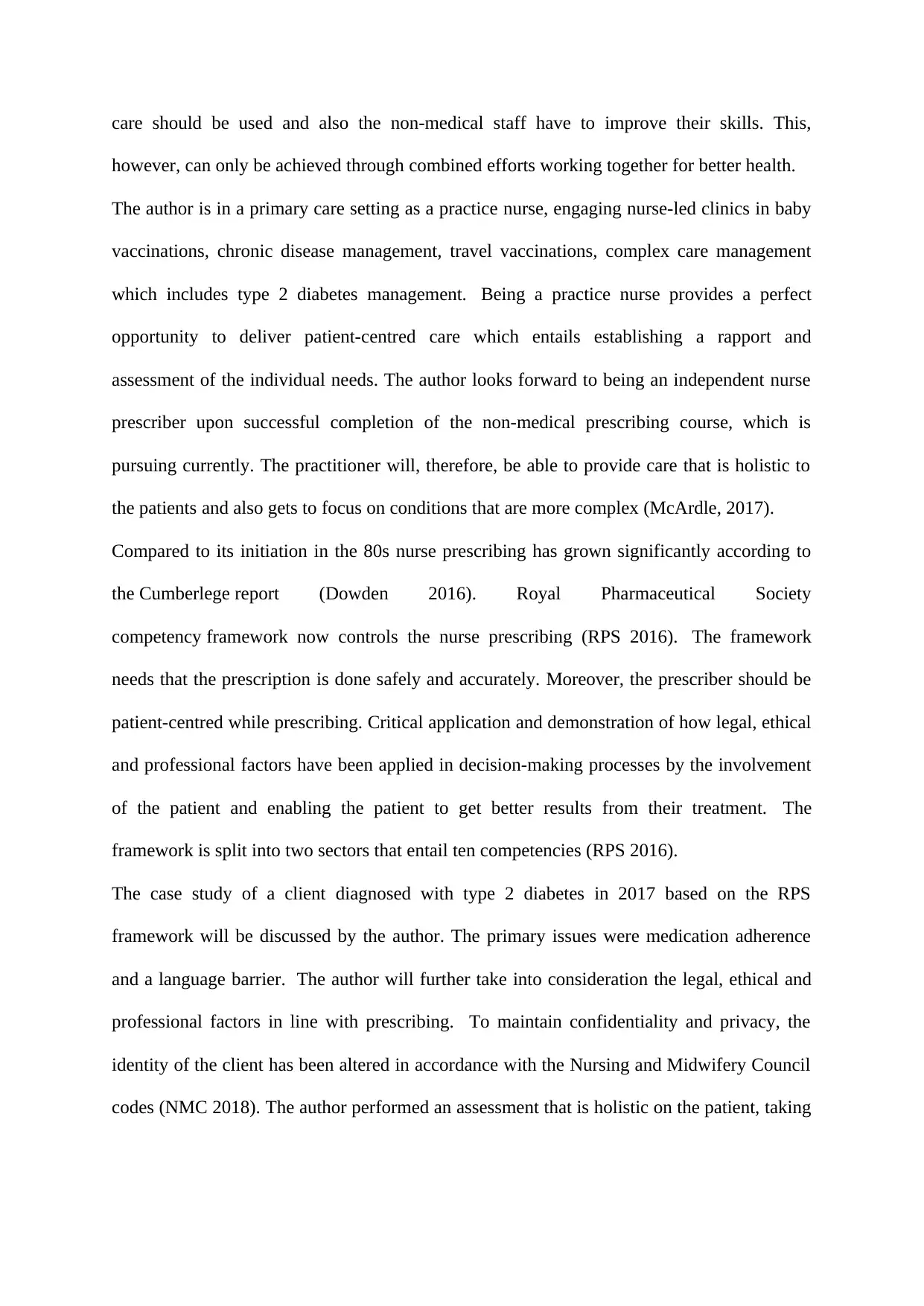
care should be used and also the non-medical staff have to improve their skills. This,
however, can only be achieved through combined efforts working together for better health.
The author is in a primary care setting as a practice nurse, engaging nurse-led clinics in baby
vaccinations, chronic disease management, travel vaccinations, complex care management
which includes type 2 diabetes management. Being a practice nurse provides a perfect
opportunity to deliver patient-centred care which entails establishing a rapport and
assessment of the individual needs. The author looks forward to being an independent nurse
prescriber upon successful completion of the non-medical prescribing course, which is
pursuing currently. The practitioner will, therefore, be able to provide care that is holistic to
the patients and also gets to focus on conditions that are more complex (McArdle, 2017).
Compared to its initiation in the 80s nurse prescribing has grown significantly according to
the Cumberlege report (Dowden 2016). Royal Pharmaceutical Society
competency framework now controls the nurse prescribing (RPS 2016). The framework
needs that the prescription is done safely and accurately. Moreover, the prescriber should be
patient-centred while prescribing. Critical application and demonstration of how legal, ethical
and professional factors have been applied in decision-making processes by the involvement
of the patient and enabling the patient to get better results from their treatment. The
framework is split into two sectors that entail ten competencies (RPS 2016).
The case study of a client diagnosed with type 2 diabetes in 2017 based on the RPS
framework will be discussed by the author. The primary issues were medication adherence
and a language barrier. The author will further take into consideration the legal, ethical and
professional factors in line with prescribing. To maintain confidentiality and privacy, the
identity of the client has been altered in accordance with the Nursing and Midwifery Council
codes (NMC 2018). The author performed an assessment that is holistic on the patient, taking
however, can only be achieved through combined efforts working together for better health.
The author is in a primary care setting as a practice nurse, engaging nurse-led clinics in baby
vaccinations, chronic disease management, travel vaccinations, complex care management
which includes type 2 diabetes management. Being a practice nurse provides a perfect
opportunity to deliver patient-centred care which entails establishing a rapport and
assessment of the individual needs. The author looks forward to being an independent nurse
prescriber upon successful completion of the non-medical prescribing course, which is
pursuing currently. The practitioner will, therefore, be able to provide care that is holistic to
the patients and also gets to focus on conditions that are more complex (McArdle, 2017).
Compared to its initiation in the 80s nurse prescribing has grown significantly according to
the Cumberlege report (Dowden 2016). Royal Pharmaceutical Society
competency framework now controls the nurse prescribing (RPS 2016). The framework
needs that the prescription is done safely and accurately. Moreover, the prescriber should be
patient-centred while prescribing. Critical application and demonstration of how legal, ethical
and professional factors have been applied in decision-making processes by the involvement
of the patient and enabling the patient to get better results from their treatment. The
framework is split into two sectors that entail ten competencies (RPS 2016).
The case study of a client diagnosed with type 2 diabetes in 2017 based on the RPS
framework will be discussed by the author. The primary issues were medication adherence
and a language barrier. The author will further take into consideration the legal, ethical and
professional factors in line with prescribing. To maintain confidentiality and privacy, the
identity of the client has been altered in accordance with the Nursing and Midwifery Council
codes (NMC 2018). The author performed an assessment that is holistic on the patient, taking
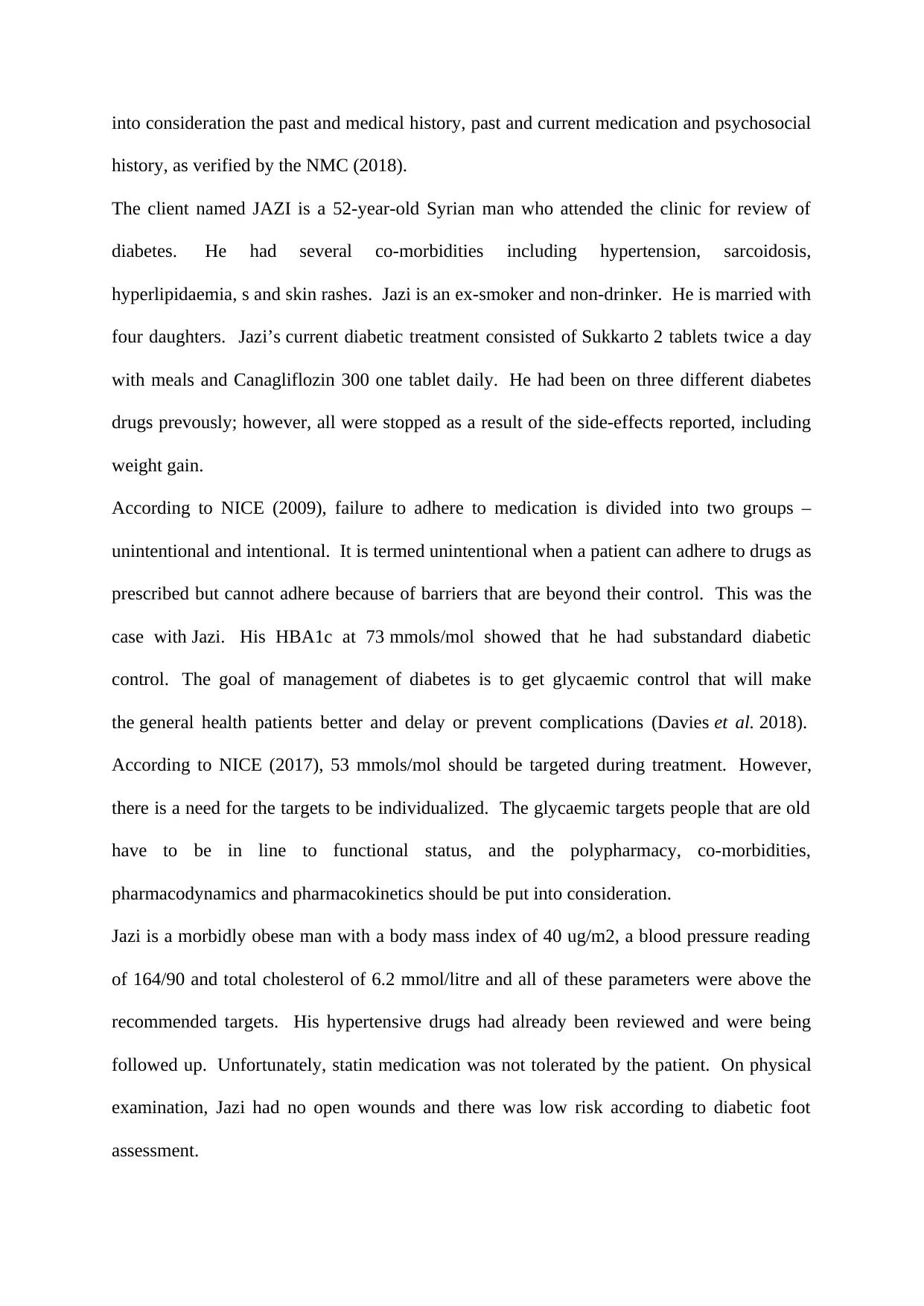
into consideration the past and medical history, past and current medication and psychosocial
history, as verified by the NMC (2018).
The client named JAZI is a 52-year-old Syrian man who attended the clinic for review of
diabetes. He had several co-morbidities including hypertension, sarcoidosis,
hyperlipidaemia, s and skin rashes. Jazi is an ex-smoker and non-drinker. He is married with
four daughters. Jazi’s current diabetic treatment consisted of Sukkarto 2 tablets twice a day
with meals and Canagliflozin 300 one tablet daily. He had been on three different diabetes
drugs prevously; however, all were stopped as a result of the side-effects reported, including
weight gain.
According to NICE (2009), failure to adhere to medication is divided into two groups –
unintentional and intentional. It is termed unintentional when a patient can adhere to drugs as
prescribed but cannot adhere because of barriers that are beyond their control. This was the
case with Jazi. His HBA1c at 73 mmols/mol showed that he had substandard diabetic
control. The goal of management of diabetes is to get glycaemic control that will make
the general health patients better and delay or prevent complications (Davies et al. 2018).
According to NICE (2017), 53 mmols/mol should be targeted during treatment. However,
there is a need for the targets to be individualized. The glycaemic targets people that are old
have to be in line to functional status, and the polypharmacy, co-morbidities,
pharmacodynamics and pharmacokinetics should be put into consideration.
Jazi is a morbidly obese man with a body mass index of 40 ug/m2, a blood pressure reading
of 164/90 and total cholesterol of 6.2 mmol/litre and all of these parameters were above the
recommended targets. His hypertensive drugs had already been reviewed and were being
followed up. Unfortunately, statin medication was not tolerated by the patient. On physical
examination, Jazi had no open wounds and there was low risk according to diabetic foot
assessment.
history, as verified by the NMC (2018).
The client named JAZI is a 52-year-old Syrian man who attended the clinic for review of
diabetes. He had several co-morbidities including hypertension, sarcoidosis,
hyperlipidaemia, s and skin rashes. Jazi is an ex-smoker and non-drinker. He is married with
four daughters. Jazi’s current diabetic treatment consisted of Sukkarto 2 tablets twice a day
with meals and Canagliflozin 300 one tablet daily. He had been on three different diabetes
drugs prevously; however, all were stopped as a result of the side-effects reported, including
weight gain.
According to NICE (2009), failure to adhere to medication is divided into two groups –
unintentional and intentional. It is termed unintentional when a patient can adhere to drugs as
prescribed but cannot adhere because of barriers that are beyond their control. This was the
case with Jazi. His HBA1c at 73 mmols/mol showed that he had substandard diabetic
control. The goal of management of diabetes is to get glycaemic control that will make
the general health patients better and delay or prevent complications (Davies et al. 2018).
According to NICE (2017), 53 mmols/mol should be targeted during treatment. However,
there is a need for the targets to be individualized. The glycaemic targets people that are old
have to be in line to functional status, and the polypharmacy, co-morbidities,
pharmacodynamics and pharmacokinetics should be put into consideration.
Jazi is a morbidly obese man with a body mass index of 40 ug/m2, a blood pressure reading
of 164/90 and total cholesterol of 6.2 mmol/litre and all of these parameters were above the
recommended targets. His hypertensive drugs had already been reviewed and were being
followed up. Unfortunately, statin medication was not tolerated by the patient. On physical
examination, Jazi had no open wounds and there was low risk according to diabetic foot
assessment.
Secure Best Marks with AI Grader
Need help grading? Try our AI Grader for instant feedback on your assignments.
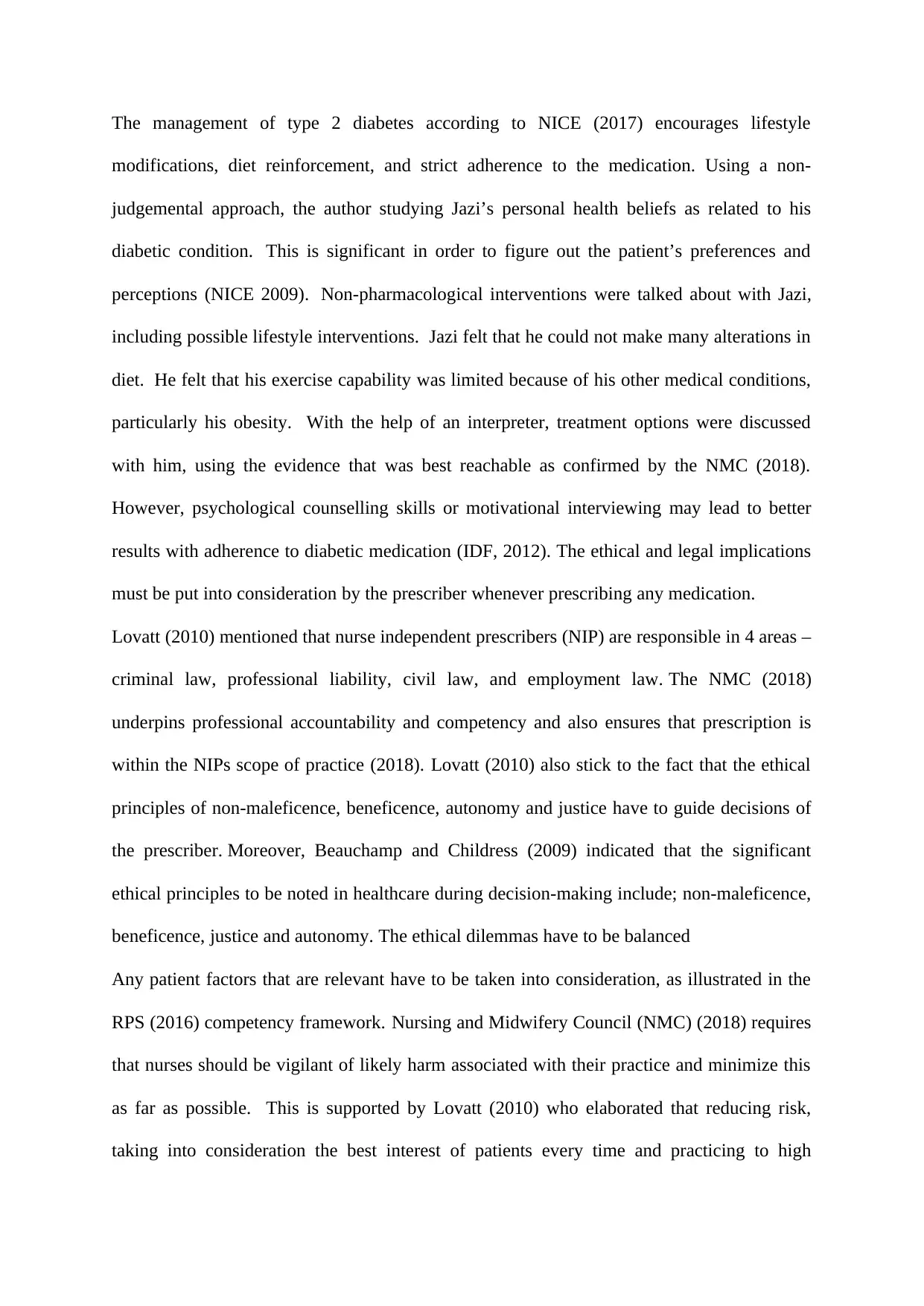
The management of type 2 diabetes according to NICE (2017) encourages lifestyle
modifications, diet reinforcement, and strict adherence to the medication. Using a non-
judgemental approach, the author studying Jazi’s personal health beliefs as related to his
diabetic condition. This is significant in order to figure out the patient’s preferences and
perceptions (NICE 2009). Non-pharmacological interventions were talked about with Jazi,
including possible lifestyle interventions. Jazi felt that he could not make many alterations in
diet. He felt that his exercise capability was limited because of his other medical conditions,
particularly his obesity. With the help of an interpreter, treatment options were discussed
with him, using the evidence that was best reachable as confirmed by the NMC (2018).
However, psychological counselling skills or motivational interviewing may lead to better
results with adherence to diabetic medication (IDF, 2012). The ethical and legal implications
must be put into consideration by the prescriber whenever prescribing any medication.
Lovatt (2010) mentioned that nurse independent prescribers (NIP) are responsible in 4 areas –
criminal law, professional liability, civil law, and employment law. The NMC (2018)
underpins professional accountability and competency and also ensures that prescription is
within the NIPs scope of practice (2018). Lovatt (2010) also stick to the fact that the ethical
principles of non-maleficence, beneficence, autonomy and justice have to guide decisions of
the prescriber. Moreover, Beauchamp and Childress (2009) indicated that the significant
ethical principles to be noted in healthcare during decision-making include; non-maleficence,
beneficence, justice and autonomy. The ethical dilemmas have to be balanced
Any patient factors that are relevant have to be taken into consideration, as illustrated in the
RPS (2016) competency framework. Nursing and Midwifery Council (NMC) (2018) requires
that nurses should be vigilant of likely harm associated with their practice and minimize this
as far as possible. This is supported by Lovatt (2010) who elaborated that reducing risk,
taking into consideration the best interest of patients every time and practicing to high
modifications, diet reinforcement, and strict adherence to the medication. Using a non-
judgemental approach, the author studying Jazi’s personal health beliefs as related to his
diabetic condition. This is significant in order to figure out the patient’s preferences and
perceptions (NICE 2009). Non-pharmacological interventions were talked about with Jazi,
including possible lifestyle interventions. Jazi felt that he could not make many alterations in
diet. He felt that his exercise capability was limited because of his other medical conditions,
particularly his obesity. With the help of an interpreter, treatment options were discussed
with him, using the evidence that was best reachable as confirmed by the NMC (2018).
However, psychological counselling skills or motivational interviewing may lead to better
results with adherence to diabetic medication (IDF, 2012). The ethical and legal implications
must be put into consideration by the prescriber whenever prescribing any medication.
Lovatt (2010) mentioned that nurse independent prescribers (NIP) are responsible in 4 areas –
criminal law, professional liability, civil law, and employment law. The NMC (2018)
underpins professional accountability and competency and also ensures that prescription is
within the NIPs scope of practice (2018). Lovatt (2010) also stick to the fact that the ethical
principles of non-maleficence, beneficence, autonomy and justice have to guide decisions of
the prescriber. Moreover, Beauchamp and Childress (2009) indicated that the significant
ethical principles to be noted in healthcare during decision-making include; non-maleficence,
beneficence, justice and autonomy. The ethical dilemmas have to be balanced
Any patient factors that are relevant have to be taken into consideration, as illustrated in the
RPS (2016) competency framework. Nursing and Midwifery Council (NMC) (2018) requires
that nurses should be vigilant of likely harm associated with their practice and minimize this
as far as possible. This is supported by Lovatt (2010) who elaborated that reducing risk,
taking into consideration the best interest of patients every time and practicing to high
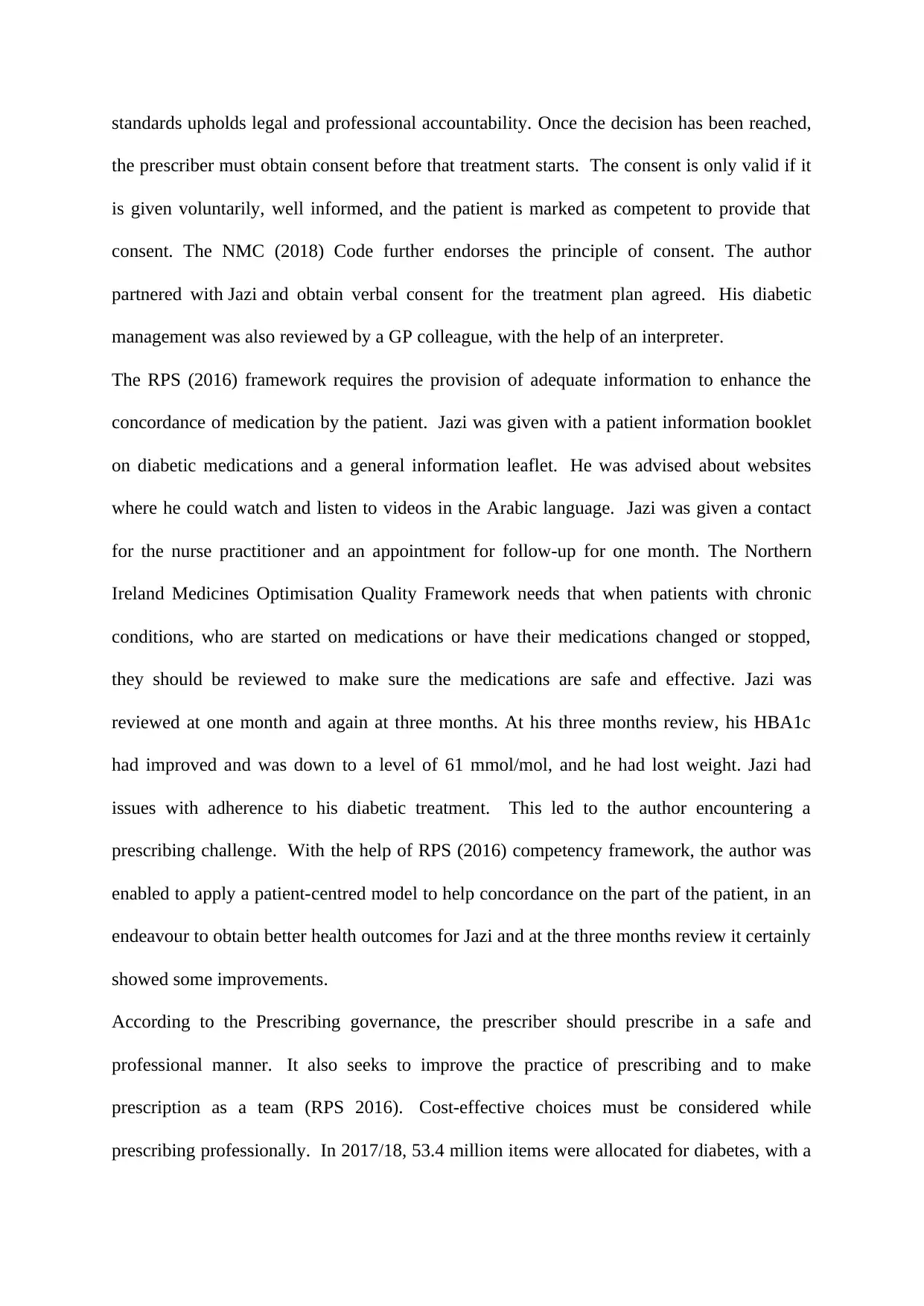
standards upholds legal and professional accountability. Once the decision has been reached,
the prescriber must obtain consent before that treatment starts. The consent is only valid if it
is given voluntarily, well informed, and the patient is marked as competent to provide that
consent. The NMC (2018) Code further endorses the principle of consent. The author
partnered with Jazi and obtain verbal consent for the treatment plan agreed. His diabetic
management was also reviewed by a GP colleague, with the help of an interpreter.
The RPS (2016) framework requires the provision of adequate information to enhance the
concordance of medication by the patient. Jazi was given with a patient information booklet
on diabetic medications and a general information leaflet. He was advised about websites
where he could watch and listen to videos in the Arabic language. Jazi was given a contact
for the nurse practitioner and an appointment for follow-up for one month. The Northern
Ireland Medicines Optimisation Quality Framework needs that when patients with chronic
conditions, who are started on medications or have their medications changed or stopped,
they should be reviewed to make sure the medications are safe and effective. Jazi was
reviewed at one month and again at three months. At his three months review, his HBA1c
had improved and was down to a level of 61 mmol/mol, and he had lost weight. Jazi had
issues with adherence to his diabetic treatment. This led to the author encountering a
prescribing challenge. With the help of RPS (2016) competency framework, the author was
enabled to apply a patient-centred model to help concordance on the part of the patient, in an
endeavour to obtain better health outcomes for Jazi and at the three months review it certainly
showed some improvements.
According to the Prescribing governance, the prescriber should prescribe in a safe and
professional manner. It also seeks to improve the practice of prescribing and to make
prescription as a team (RPS 2016). Cost-effective choices must be considered while
prescribing professionally. In 2017/18, 53.4 million items were allocated for diabetes, with a
the prescriber must obtain consent before that treatment starts. The consent is only valid if it
is given voluntarily, well informed, and the patient is marked as competent to provide that
consent. The NMC (2018) Code further endorses the principle of consent. The author
partnered with Jazi and obtain verbal consent for the treatment plan agreed. His diabetic
management was also reviewed by a GP colleague, with the help of an interpreter.
The RPS (2016) framework requires the provision of adequate information to enhance the
concordance of medication by the patient. Jazi was given with a patient information booklet
on diabetic medications and a general information leaflet. He was advised about websites
where he could watch and listen to videos in the Arabic language. Jazi was given a contact
for the nurse practitioner and an appointment for follow-up for one month. The Northern
Ireland Medicines Optimisation Quality Framework needs that when patients with chronic
conditions, who are started on medications or have their medications changed or stopped,
they should be reviewed to make sure the medications are safe and effective. Jazi was
reviewed at one month and again at three months. At his three months review, his HBA1c
had improved and was down to a level of 61 mmol/mol, and he had lost weight. Jazi had
issues with adherence to his diabetic treatment. This led to the author encountering a
prescribing challenge. With the help of RPS (2016) competency framework, the author was
enabled to apply a patient-centred model to help concordance on the part of the patient, in an
endeavour to obtain better health outcomes for Jazi and at the three months review it certainly
showed some improvements.
According to the Prescribing governance, the prescriber should prescribe in a safe and
professional manner. It also seeks to improve the practice of prescribing and to make
prescription as a team (RPS 2016). Cost-effective choices must be considered while
prescribing professionally. In 2017/18, 53.4 million items were allocated for diabetes, with a
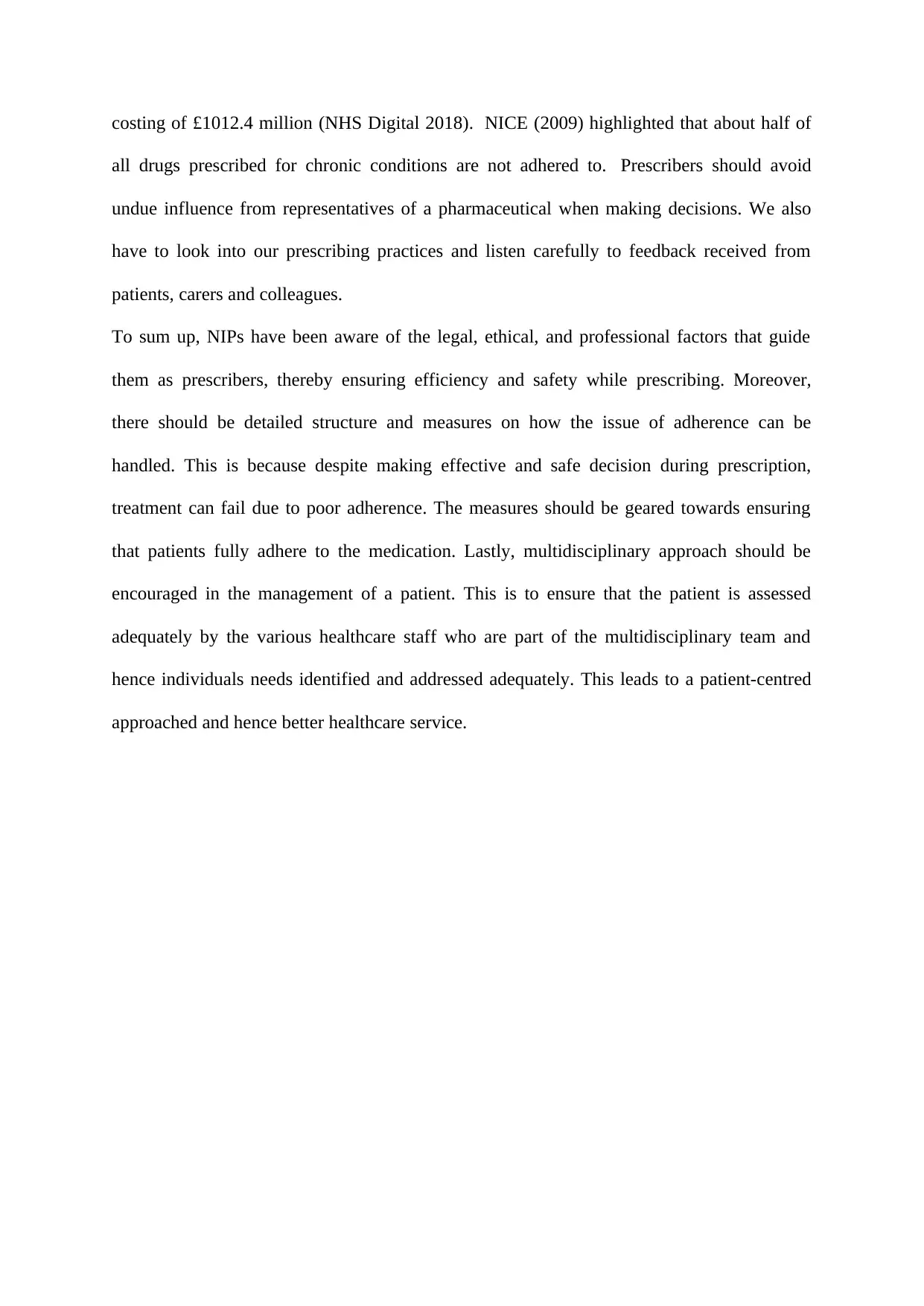
costing of £1012.4 million (NHS Digital 2018). NICE (2009) highlighted that about half of
all drugs prescribed for chronic conditions are not adhered to. Prescribers should avoid
undue influence from representatives of a pharmaceutical when making decisions. We also
have to look into our prescribing practices and listen carefully to feedback received from
patients, carers and colleagues.
To sum up, NIPs have been aware of the legal, ethical, and professional factors that guide
them as prescribers, thereby ensuring efficiency and safety while prescribing. Moreover,
there should be detailed structure and measures on how the issue of adherence can be
handled. This is because despite making effective and safe decision during prescription,
treatment can fail due to poor adherence. The measures should be geared towards ensuring
that patients fully adhere to the medication. Lastly, multidisciplinary approach should be
encouraged in the management of a patient. This is to ensure that the patient is assessed
adequately by the various healthcare staff who are part of the multidisciplinary team and
hence individuals needs identified and addressed adequately. This leads to a patient-centred
approached and hence better healthcare service.
all drugs prescribed for chronic conditions are not adhered to. Prescribers should avoid
undue influence from representatives of a pharmaceutical when making decisions. We also
have to look into our prescribing practices and listen carefully to feedback received from
patients, carers and colleagues.
To sum up, NIPs have been aware of the legal, ethical, and professional factors that guide
them as prescribers, thereby ensuring efficiency and safety while prescribing. Moreover,
there should be detailed structure and measures on how the issue of adherence can be
handled. This is because despite making effective and safe decision during prescription,
treatment can fail due to poor adherence. The measures should be geared towards ensuring
that patients fully adhere to the medication. Lastly, multidisciplinary approach should be
encouraged in the management of a patient. This is to ensure that the patient is assessed
adequately by the various healthcare staff who are part of the multidisciplinary team and
hence individuals needs identified and addressed adequately. This leads to a patient-centred
approached and hence better healthcare service.
Paraphrase This Document
Need a fresh take? Get an instant paraphrase of this document with our AI Paraphraser
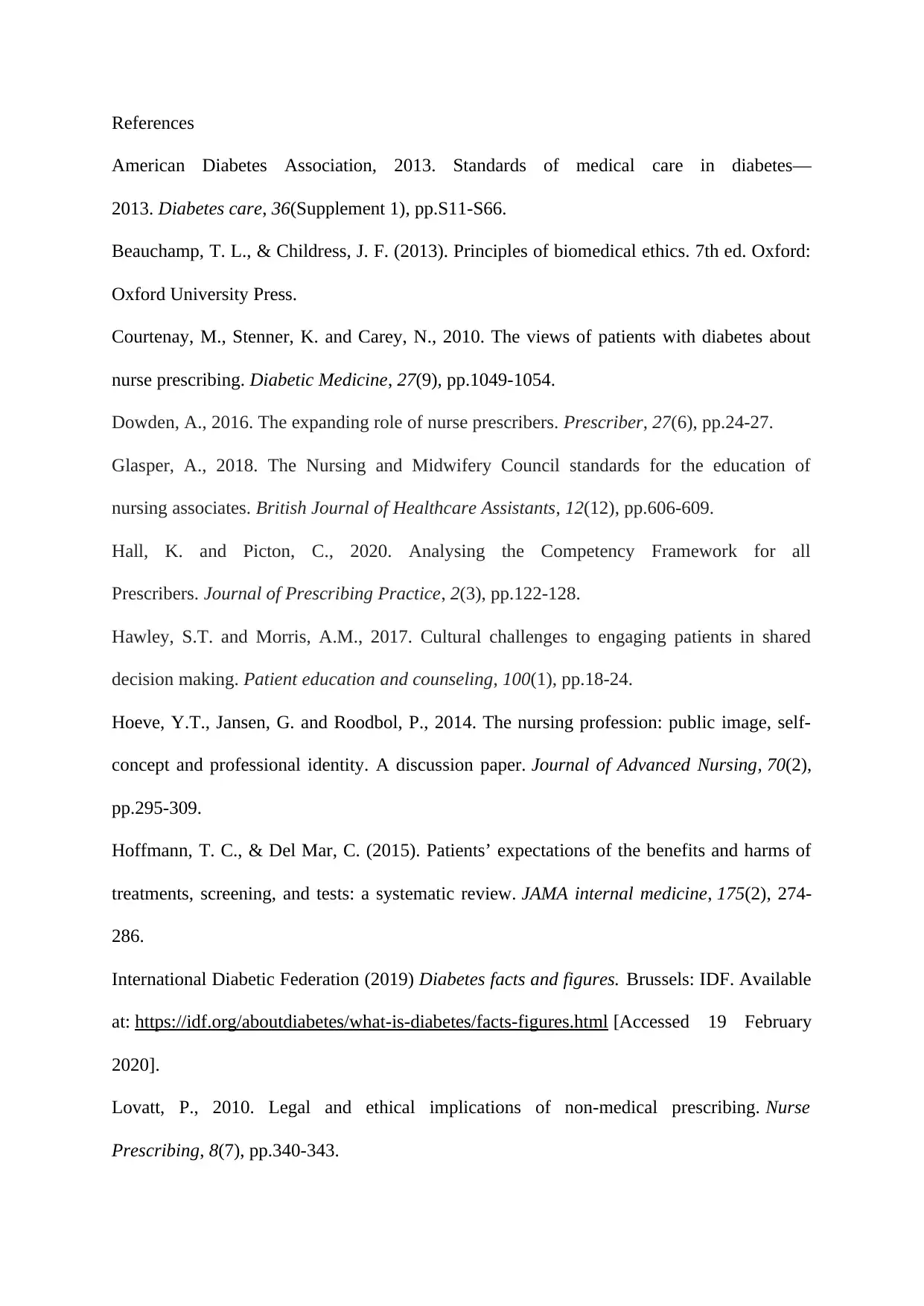
References
American Diabetes Association, 2013. Standards of medical care in diabetes—
2013. Diabetes care, 36(Supplement 1), pp.S11-S66.
Beauchamp, T. L., & Childress, J. F. (2013). Principles of biomedical ethics. 7th ed. Oxford:
Oxford University Press.
Courtenay, M., Stenner, K. and Carey, N., 2010. The views of patients with diabetes about
nurse prescribing. Diabetic Medicine, 27(9), pp.1049-1054.
Dowden, A., 2016. The expanding role of nurse prescribers. Prescriber, 27(6), pp.24-27.
Glasper, A., 2018. The Nursing and Midwifery Council standards for the education of
nursing associates. British Journal of Healthcare Assistants, 12(12), pp.606-609.
Hall, K. and Picton, C., 2020. Analysing the Competency Framework for all
Prescribers. Journal of Prescribing Practice, 2(3), pp.122-128.
Hawley, S.T. and Morris, A.M., 2017. Cultural challenges to engaging patients in shared
decision making. Patient education and counseling, 100(1), pp.18-24.
Hoeve, Y.T., Jansen, G. and Roodbol, P., 2014. The nursing profession: public image, self‐
concept and professional identity. A discussion paper. Journal of Advanced Nursing, 70(2),
pp.295-309.
Hoffmann, T. C., & Del Mar, C. (2015). Patients’ expectations of the benefits and harms of
treatments, screening, and tests: a systematic review. JAMA internal medicine, 175(2), 274-
286.
International Diabetic Federation (2019) Diabetes facts and figures. Brussels: IDF. Available
at: https://idf.org/aboutdiabetes/what-is-diabetes/facts-figures.html [Accessed 19 February
2020].
Lovatt, P., 2010. Legal and ethical implications of non-medical prescribing. Nurse
Prescribing, 8(7), pp.340-343.
American Diabetes Association, 2013. Standards of medical care in diabetes—
2013. Diabetes care, 36(Supplement 1), pp.S11-S66.
Beauchamp, T. L., & Childress, J. F. (2013). Principles of biomedical ethics. 7th ed. Oxford:
Oxford University Press.
Courtenay, M., Stenner, K. and Carey, N., 2010. The views of patients with diabetes about
nurse prescribing. Diabetic Medicine, 27(9), pp.1049-1054.
Dowden, A., 2016. The expanding role of nurse prescribers. Prescriber, 27(6), pp.24-27.
Glasper, A., 2018. The Nursing and Midwifery Council standards for the education of
nursing associates. British Journal of Healthcare Assistants, 12(12), pp.606-609.
Hall, K. and Picton, C., 2020. Analysing the Competency Framework for all
Prescribers. Journal of Prescribing Practice, 2(3), pp.122-128.
Hawley, S.T. and Morris, A.M., 2017. Cultural challenges to engaging patients in shared
decision making. Patient education and counseling, 100(1), pp.18-24.
Hoeve, Y.T., Jansen, G. and Roodbol, P., 2014. The nursing profession: public image, self‐
concept and professional identity. A discussion paper. Journal of Advanced Nursing, 70(2),
pp.295-309.
Hoffmann, T. C., & Del Mar, C. (2015). Patients’ expectations of the benefits and harms of
treatments, screening, and tests: a systematic review. JAMA internal medicine, 175(2), 274-
286.
International Diabetic Federation (2019) Diabetes facts and figures. Brussels: IDF. Available
at: https://idf.org/aboutdiabetes/what-is-diabetes/facts-figures.html [Accessed 19 February
2020].
Lovatt, P., 2010. Legal and ethical implications of non-medical prescribing. Nurse
Prescribing, 8(7), pp.340-343.
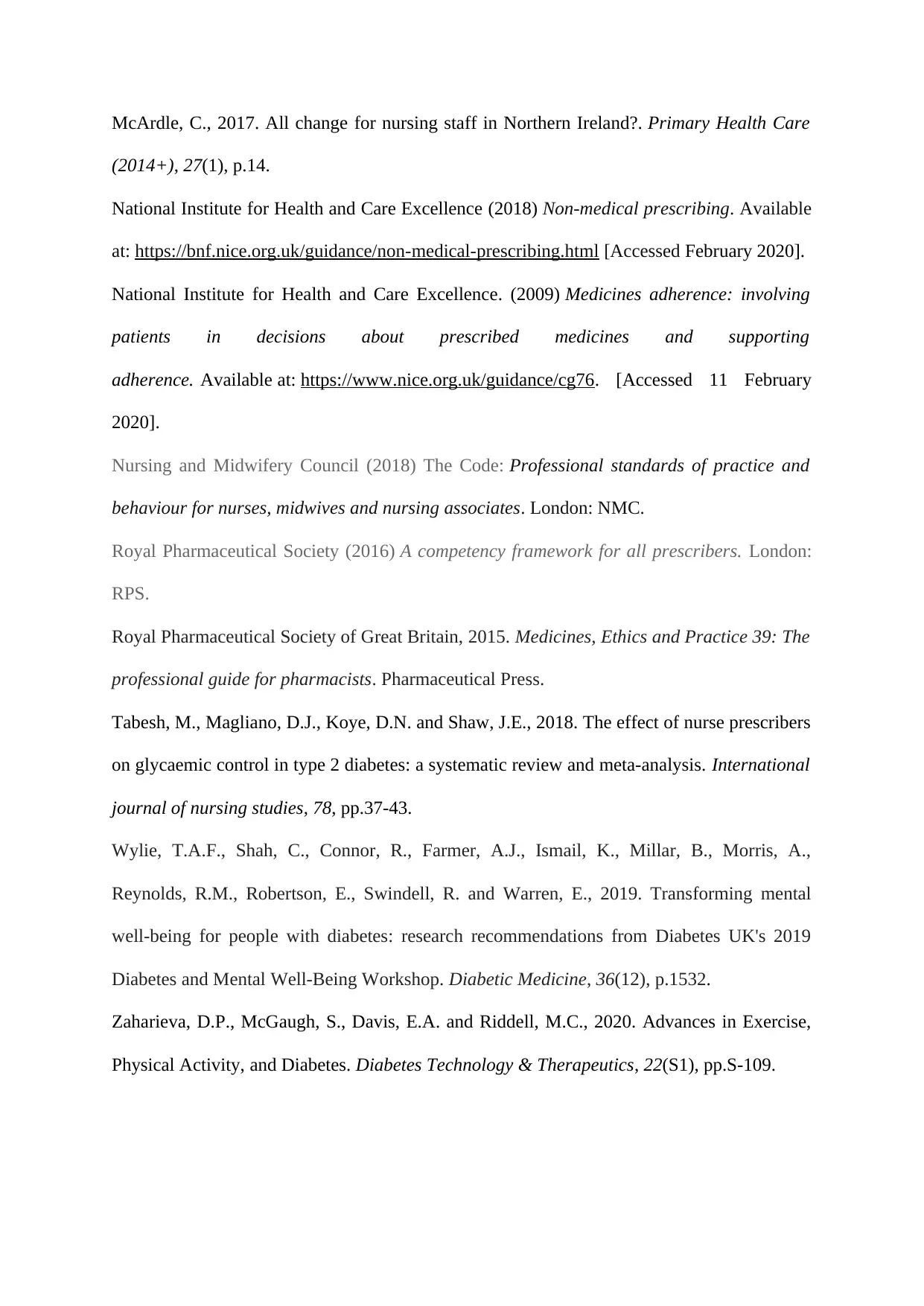
McArdle, C., 2017. All change for nursing staff in Northern Ireland?. Primary Health Care
(2014+), 27(1), p.14.
National Institute for Health and Care Excellence (2018) Non-medical prescribing. Available
at: https://bnf.nice.org.uk/guidance/non-medical-prescribing.html [Accessed February 2020].
National Institute for Health and Care Excellence. (2009) Medicines adherence: involving
patients in decisions about prescribed medicines and supporting
adherence. Available at: https://www.nice.org.uk/guidance/cg76. [Accessed 11 February
2020].
Nursing and Midwifery Council (2018) The Code: Professional standards of practice and
behaviour for nurses, midwives and nursing associates. London: NMC.
Royal Pharmaceutical Society (2016) A competency framework for all prescribers. London:
RPS.
Royal Pharmaceutical Society of Great Britain, 2015. Medicines, Ethics and Practice 39: The
professional guide for pharmacists. Pharmaceutical Press.
Tabesh, M., Magliano, D.J., Koye, D.N. and Shaw, J.E., 2018. The effect of nurse prescribers
on glycaemic control in type 2 diabetes: a systematic review and meta-analysis. International
journal of nursing studies, 78, pp.37-43.
Wylie, T.A.F., Shah, C., Connor, R., Farmer, A.J., Ismail, K., Millar, B., Morris, A.,
Reynolds, R.M., Robertson, E., Swindell, R. and Warren, E., 2019. Transforming mental
well‐being for people with diabetes: research recommendations from Diabetes UK's 2019
Diabetes and Mental Well‐Being Workshop. Diabetic Medicine, 36(12), p.1532.
Zaharieva, D.P., McGaugh, S., Davis, E.A. and Riddell, M.C., 2020. Advances in Exercise,
Physical Activity, and Diabetes. Diabetes Technology & Therapeutics, 22(S1), pp.S-109.
(2014+), 27(1), p.14.
National Institute for Health and Care Excellence (2018) Non-medical prescribing. Available
at: https://bnf.nice.org.uk/guidance/non-medical-prescribing.html [Accessed February 2020].
National Institute for Health and Care Excellence. (2009) Medicines adherence: involving
patients in decisions about prescribed medicines and supporting
adherence. Available at: https://www.nice.org.uk/guidance/cg76. [Accessed 11 February
2020].
Nursing and Midwifery Council (2018) The Code: Professional standards of practice and
behaviour for nurses, midwives and nursing associates. London: NMC.
Royal Pharmaceutical Society (2016) A competency framework for all prescribers. London:
RPS.
Royal Pharmaceutical Society of Great Britain, 2015. Medicines, Ethics and Practice 39: The
professional guide for pharmacists. Pharmaceutical Press.
Tabesh, M., Magliano, D.J., Koye, D.N. and Shaw, J.E., 2018. The effect of nurse prescribers
on glycaemic control in type 2 diabetes: a systematic review and meta-analysis. International
journal of nursing studies, 78, pp.37-43.
Wylie, T.A.F., Shah, C., Connor, R., Farmer, A.J., Ismail, K., Millar, B., Morris, A.,
Reynolds, R.M., Robertson, E., Swindell, R. and Warren, E., 2019. Transforming mental
well‐being for people with diabetes: research recommendations from Diabetes UK's 2019
Diabetes and Mental Well‐Being Workshop. Diabetic Medicine, 36(12), p.1532.
Zaharieva, D.P., McGaugh, S., Davis, E.A. and Riddell, M.C., 2020. Advances in Exercise,
Physical Activity, and Diabetes. Diabetes Technology & Therapeutics, 22(S1), pp.S-109.
1 out of 9
Related Documents
Your All-in-One AI-Powered Toolkit for Academic Success.
+13062052269
info@desklib.com
Available 24*7 on WhatsApp / Email
![[object Object]](/_next/static/media/star-bottom.7253800d.svg)
Unlock your academic potential
© 2024 | Zucol Services PVT LTD | All rights reserved.





